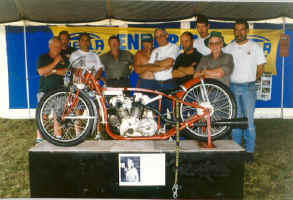The Burt Munro Story |
|
| I knew he was on the
salt and had heard some talk of his mission. I was impressed by the
sight of his bike and had watched him make a qualifying run. He got my
interest early on because of what he was doing and his advanced years...I
was 32, he was 63. (In time, I was to understand and see that in a
different light.)
I first talked to Burt at the nine mile post on record runs in 1962. It was my job at the post to talk to the drivers/riders and inform them of the proper procedures for making the return run. When he came rolling in at the end of his first leg of his record run, he got off his bike, his right pant leg was soaked with fuel and his face was full of salt. He smiled and said, "I say , its a might salty out there." As was often the case with others, in the excitement surrounding the moment, he did not heed my recommendations for making his return run. In order for him to have his speed in the correct mile on return, he needed to take it easy for the first couple of miles and then lean on it to make his record. He left the nine mile at full throttle and blew the engine before he reached the timing traps. Although he failed on this attempt, he came back later in the week to set the record. In the coming days and years, I came to know and appreciate this man and his stories. He was indeed a man on a mission, a man short on funds and long on determination. He was delightful to listen to. His wit and philosophy of life made an impression on me. His favorite comment was, "Make Do!" I understood what that meant since I was also a person with little funds to pursue my dream and often I had to do with less than I would have liked. "Make do" was often employed in my mission as well. There is a story told by Rollie Free, Burt's friend and companion on his first trip to the salt. Burt had purchased an old Nash sedan, a 1941, I believe, to tow his motorcycle. (The movie uses a '54 Chevrolet) During the trip to the salt, the transmission broke some gears and punched a hole in the transmission case. Rollie wanted to go to a wrecking yard and find another transmission, but Burt said, we'll Make Do." He pulled the transmission, removed the broken parts, whittled a wooden plug and drove it in the hole in the case. That is the way they continued to use the Nash. This was not an unusual event for Burt. This is the way he lived! The following was taken from the internet. It is the contents of a couple of letters written by Burt to a friend chronicling his life's pursuit of speed.. |
|
H. J 'Bert Munro' 1899-1977' |
|
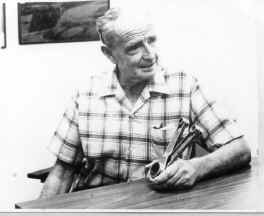 |
Well it is a bit hard to cram a brief
history and spec of a bike I bought new in 1920 for 140 pounds cash and
have been developing since 1926. it has gone 3 ¼ m.p.h. faster
each year for 44 years which is about average for some factory bikes
over the same period. I have been riding since 1915 and owned a Clyno
v-twin in 1919- 1920 which I sold to a blacksmith and then bought the
1920 Scout, engine number 5OR627. I have made 5 heads for it, countless
pistons and conrods, carburetors, magneto parts , scores of cams, fork
changes, many wheels built as tyres and rims changed. The last one was
for the front wheel last July when I changed from 19" to 18" as I
cannot get high speed from 19 x 2.75 tires anymore. This I cut the
tread off with a knife then smoothed down to the bottom of the non-skid
groove.
For the first 22 years after 1926 it was weekends and nights getting ready for hill-climbs, trials and standing ¼ and flying ¼ mile events, and 1 mile dirt sidecar races at Penrith Speedway, NSW, Australia. Between 26 and 29 I had records in hill-climbs, standing ¼ and flying ¼, and petrol consumption runs, one of 116 m.p.g. |
|
|
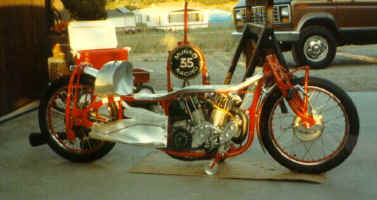 |
In 1948 I decided to give up work and concentrate on getting a good run out of my old bike as by this time I thought I was getting better at designing parts and would go to the Canterbury Speed Trials held each year north of Christchurch. Well I went there for 22 years, this was a 1,000 mile round trip from home. I broke the NZ records more than once, but was only three times satisfied I had gone as good as I could go at the time, and those three times their timer failed for me. The last time was 10 or 11 years ago and the ACU rep said, never mind, next year we will have cable buried in side of the road. Then they could not get it anymore because of increased use of this long straight road known as Tram Road, North Canterbury, NZ. |
|
I will try and give you a rough
specification of the past and present of engine and cycle. I have and
still hold some records in the 37 ci class, under 750 cc class, 55ci
class and lastly 61ci class, all with my 1920 flathead Scout. My first
major record was the NZ Open Road record established on the Aylesbury
straight in 1940 at a mean 120.8m.p.h. This was held for twelve years.
The under 750 cc Road record at 143.43 and NZ Open Road record at the
same time. Also NZ Beach record in 1957. Although this is still
attempted each year it remains unbroken at 132.38 m.p.h.
55 ci AMA world record 1962 at Bonneville, engine was 51ci at this
time. 1966 engine 56ci 168.06m.p.h. American 61 ci record 1967 183.6.
best run 190.07 qualifying. 1969 record number of runs for a
streamliner, 14 in four and a half days. I had magneto and carburetion
troubles and finally burned-up pistons when gas tap shut off on last
chance of a qualifying run. I have hauled bike or engine to USA eight
times in my attempt to get one good run but this has always eluded my
greatest efforts. The last 22 years has been full-time as I could never get enough hours to do things. After finally getting 94 m.p.h. from the flatheads and running on Borneo Aviation Gas I had a go at making ohv heads. A foundry told me how to go about making patterns and I finally had them finished after a year of work until the first day it ran. Believe it or not the first runs were slower than my best on the sidevalve but over the years I gradually got it going faster till in 1937 I was getting 110 m.p.h. from it, also breaking conrods. About then a mate and I were returning from a distant beach meeting and another pair of rods had broken, and he said why not write to the Indian factory and get special rods. This got me thinking and I acquired a broken Ford truck axle and carved out two rods in five months. These were in it for 20 years and were standing up to over 140 m.p.h. By 1950 I was getting 150 m.p.h unstreamlined. |
|

|
I have had many terrific blow-ups, the last two were during this last 11 months. I will describe one I had at Muriwai Beach, Auckland in April 1969. I hauled my Munro Special up there 1130 miles and blew a piston ( I had just made thirteen new ones for 1969), the rod and pin toe up and down, put tram tracks and split both new cylinders, punched large hole in front of case, bent mag armature, broke slip ring and magnets on ML into five pieces. I hauled home and in eight and a half weeks had it running again. Eight more new pistons, two new home made rods, magnets cut form an old Bosch magneto. The brief history is almost impossible to put together but I should give you a rough idea of some of my best crashes. |
| In 1916, out all day after landing on head. 1921, riding standing on seat of Scout waiting for Uncle Alf to get his King Dickgoing. I looked round and woke up that evening after a whole days absence from what was going on. In 1927, jumped off on a dirt track Aspendale Speedway at over 90mph. Concussion and bruising from feet to back of neck. 1932, stopped to get a rider going in Western Southland when on my traveling job. I told the guy I would follow him in case it stopped again. We came to a farmhouse at a cross road. A dog ran at him. I caught it on the rebound and came around later concussed and bloody from a deep scalp wound. 1934, crashed Clifton Gorge, struck a wash-out before could pull-up. Came around concussed. 1937, in 20 mile beach race, doing 110 when Hugh Currie, BSA Special, the last rider I had to catch, turned in front of me. I hit the 6" brake and tried to steer behind him as he banked over to turn. My bike climbed up and over his and sailed 120 feet clear of the beach before landing. He was knocked-out and had broken collar bone. My bash-hat was split from crown to rim in two places. Weeks later he told me what knocked me out and split the hat. The underside of his engine landed square on my head. When he was repairing his bike he found the varnish marks from my hat on the cases. I had all my teeth knocked out and my brother picked up numerous gold filled ones from the sand. This was one of the saddest moments of my life when I found my priceless teeth no more. | |
|
|
|
|
|
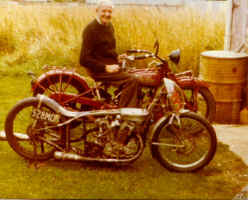 |
The man himself on a 101 Scout with his special in the foreground. Note the startling lack of ornamentation! For 10 years I worked 16 hours a day in the shed and was told to slow up a few years ago and now work 7 days and about 70 hours a week. The flywheels I made form 5" axle hammered out under steam hammer. Just finished pistons. I had these eight heat-treated for the first time. Crank in 1928 Scout turned down to ¾" and then sleeved. I made this from oil hardening steel and squeeze on and pull up with standard nuts. I leave the taper with ¾" hole in it to fit drive side flywheel. The rods of course now have bigger eye and smaller rollers. The main shafts right up to about three years ago were standard, about 13/16"; with four sets of caged genuine Indian rollers ¼ x 5/16" running on the shafts. Well, as speed mounted-up over the years I got visions of them breaking and in 1957 I had a new pin, crank-pin that is, given to me in Springfield on a visit to Indian factory. This I fitted to the timing side with big-end bearings. |
| Then the drive side looked so thin. I looked around and had a spare gearbox mainshaft. So I ground the four outside splines off it and made up two drive shafts form it, then had them re-hardened and ground locally. I bored out the taper in flywheel in my three and a half inch Myford lathe. By the way, I completely made my new cylinder heads in the same lathe. The only change is to cut about one and a quarter off gap in bed for flywheels. This probably weakens it a bit but I still work it every day, and have since it was new 22 years ago. I am on my second set of back gears, worn out about 12 years ago, and my third lead screw is now badly worn. | |
| Cams I made by file and saw since 1926 but now have built a cam grinder and make them in pairs as I spent 800 hours in 1963 making the engine into a four cam set-up. After I time them I pin them to the ¼" hole in the standard cam-wheels on Scout. Cam followers are filed from axle steel and I make a fork to take a ¾" x ¼" roller running on needles, and an oiler to keep a good flow from the 1933 Indian oil pump I had given me in 1956. This I modified to pump the oil to big end, and was when I made my steel flywheels. | |
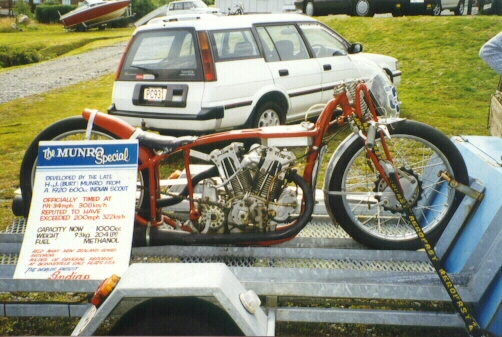 |
The 1920 Scout frame and my third streamliner shell are still in USA. The first full shell I built tool me five years to hammer out of sheet aluminum. I could only work at it when I had my bike ready for testing then if it blew-up I would work on the engine until running again, then hammer away at it again, or suddenly think of some new scheme to get more speed. Of course these brainwaves often made it slower or just more blown parts. By the way, I have read of E Fernihough's death and perhaps I can offer a reason for him running off the road that day. I have several times had similar experiences caused by a side wind of only two to three m.p.h. if one is traveling at over 180 as on most occasions with me, the bike steers over to one side but I start to steer it back at once. But I have had it go 12 feet over the outside of the black line before getting it back to the center of track. If this were on a road of course there is no chance of survival. |
 |
The first shell I took with me to Bonneville in 1962 was the second I had built. The first one of aluminum was too hard to ride, too neat a fit and I had great difficulty getting the gears. So I modified it and used it as a mould for number two of fiberglass. I had my first run on it at Bonneville in 1962, and was ordered to have a test run with officials following in a car. It just veered from side to side at all speeds. I said to myself I may as well ship it back home, they will never let me run a thing like this. When they came up with me they said, handles ok. I said, What! They repeated handled good. |
|
|
Return to Bryant Racing Return
